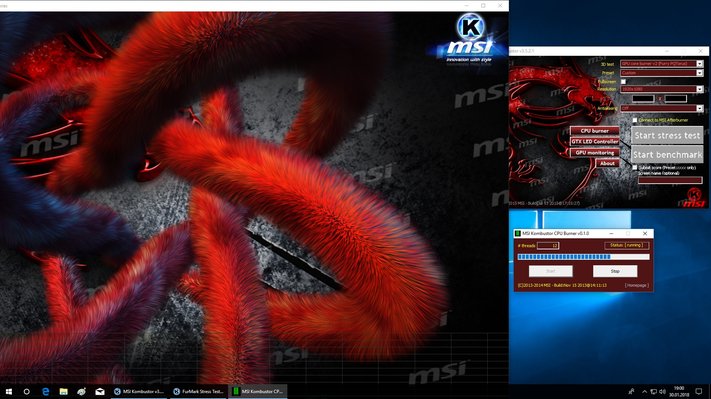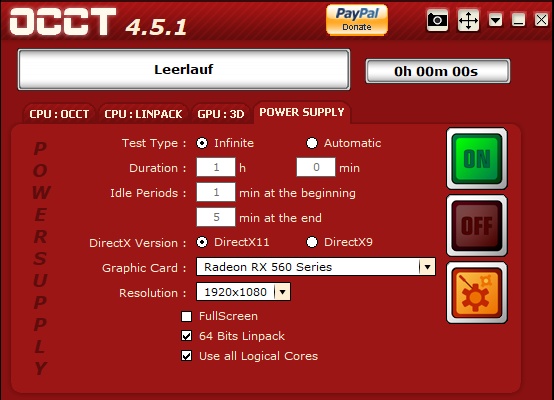MSI Combuster in full test
The MSI combuster has a built-in CPU stress test, which does not rely on AVX code, but generates an average load for this CPU with just below 110 watts for this CPU, which is quite the same as that of a very demanding game and even slightly above it. However, since it is not for a pure CPU stress test in this form, we only used this test in combination with the also built-in GPU stress test.
This makes it possible to simulate games in their maximum form in terms of power consumption and heat generation quite well, because no current game of load will generate more. Quite the opposite. The advantage of the action: the entire threads and the GPU stress test run below the same application and thus also with the same priority. However, we recommend that you run the GPU stress test in windowed mode as long as you don't want to stress a multi-GPU system.

GPU Core Burner
First, we put the full load on the GPU again and let the CPU stress test simply run side by side. The result corresponds exactly to what we just wrote about the program:
| CPU Package (PECI) |
Core Average |
Sensor Socket |
GPU Diode |
Cpu Watts |
Gpu Watts |
System Watts |
|
|---|---|---|---|---|---|---|---|
| Reading |
73 °C | 65 °C | 76 °C | 64 °C |
108 W |
101 W |
259 W |
| Compared to The Max. |
85.9 % | 76.5% | 73.1 % | 100% |
63.5 % |
100% |
72.5 % |
| Review | – medium package temperature – average base temperature – average storage temperature – GPU power consumption to maximum – Power consumption of the CPU slightly above game level |
||||||
| Suitability | – Normal load on the overall system – Simulation of the most demanding games |
||||||
Memory Burner
The same applies as well as the same, whereby the focus is now still moving in the direction of the extensive use of the graphics memory. This test is therefore also one of our recommendations for assessing whether a system is capable of thermally and supply-related lysmically even in the most demanding games.
| CPU Package (PECI) |
Core Average |
Sensor Socket |
GPU Diode |
Cpu Watts |
Gpu Watts |
System Watts |
|
|---|---|---|---|---|---|---|---|
| Reading |
67 °C | 66 °C | 78 °C | 64 °C |
109 W |
100 W | 260 W |
| Compared to The Max. |
78.8 % | 77.6% | 75.0 % | 100% |
64.5 % |
99% | 72.8 % |
| Review | – slightly lower package temperature – average base temperature – average storage temperature – GPU power consumption almost to maximum – Power consumption of the CPU slightly above game level |
||||||
| Suitability | – Normal load on the overall system – Very good simulation of the most demanding games |
||||||
OCCT "Power Supply"
In this test, OCCT simulates CPU and GPU usage to test the stability of the power supply for the overall system. That is at least the case.

It doesn't always have to be the big heat cinema if you want to test the PC for its thermal suitability for games. Tests such as this one, where game-like power consumption values are generated, are primarily used to optimize cooling systems and fan curves. If everything stays in the green area up to this point, this and the two previous tests can be used to determine the optimum for the lowest possible operating noise (e.g. housing ventilation and ventilation).
Anything that is then above it in terms of performance can be well intercepted in later more aggressive fan curves. So you should first secure the absolute maximum and explore the area of optimization exactly with this.
| CPU Package (PECI) |
Core Average |
Sensor Socket |
GPU Diode |
Cpu Watts |
Gpu Watts |
System Watts |
|
|---|---|---|---|---|---|---|---|
| Reading |
64 °C | 64 °C | 68 °C | 63 °C | 108 W |
98 W | 266 W |
| Compared to The Max. |
75.3 % | 75.3% | 65.4 % | 98.4 % | 63.9 % |
97% | 74.5 % |
| Review | – lower package temperature – average base temperature – average storage temperature – GPU power consumption at game level – Power consumption of the CPU slightly above game level |
||||||
| Suitability | – Normal load on the overall system – Very good simulation of the most demanding games |
||||||
- 1 - Einführung und Testsystem
- 2 - Prime95 mit AVX oder SSE
- 3 - OCCT mit vier Varianten
- 4 - Aida64: FPU vs. Cache vs. Memory
- 5 - powerMAX, Heavy Load
- 6 - CPU Only: Leistungsaufnahme
- 7 - CPU Only: Temperaturen
- 8 - System: Prime95 + GPU
- 9 - System: MSI Kombustor, OCCT
- 10 - System: Aida64, powerMAX, Heavy Load
- 11 - System: Leistungsaufnahme
- 12 - System: Temperaturen
- 13 - Zusammenfassung und Fazit

































Kommentieren